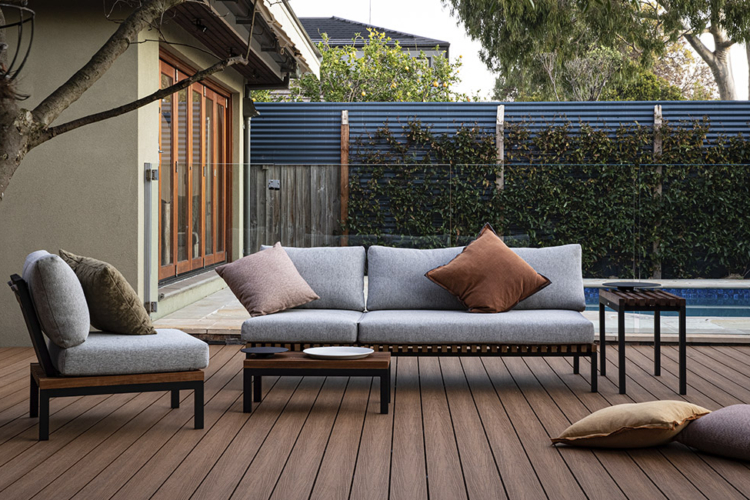
Composite vs Timber
Whilst there are a lot of similar characteristics between timber and composites, they also differ in many ways. Explore more about the differences, strengths and weaknesses between the two below.
| Ekodeck | Timber | |
|---|---|---|
| Requires no oiling/sealing maintenance |  |  |
| Naturally resistant to rot, decay and termites |  |  |
| Concealed fixings |  | Limited options |
| Anti-slip rated |  |  |
| UV Stabilised |  |  |
| Will not fade to grey |  |  |
| Will not splinter, cup, twist or warp |  |  |
| Straight and consistent lengths |  |  |
| Up to 25-year warranty |  |  |
| Janka rating (measure of hardness and durability) | 10.5 | 8.6 (Kwila) |
Composite vs Timber
Maintenance
Timber decks require regular oiling, painting or sealing to keep them looking fresh all year round, as well as protected from the harsh New Zealand elements.
Composite decking is a pre-finished product, meaning that there is no oiling, painting or sealing required – a good clean every now and then is all you need.
Rot
Moisture can be a real problem for timber decks if a strict sealing and maintenance schedule is not followed, especially in hard to reach areas. With it’s porous nature, timber has a tendency to absorb surrounding moisture, which can lead to rot over time.
Comparably, composite decking has low water absorption rates of approximately 0.5 – 1.5%, resulting in a superior resistance against rot and decay.
Behaviour
With a moisture content of 10-15%, timber can shrink and splinter as it dries out. Swelling across the width of timber decking also occurs with the absorption of water.
Composites behave differently due their plastic component – as composite boards absorb heat, they expand along their length. Because of this, composites require a slightly different installation technique to allow for proper gapping between the boards.
Colour/fading
If left untreated, timber will fade to grey. A consistent maintenance schedule is needed, including oiling or sealing, but being a porous, organic material means that a timber deck will become dull as the years go on, despite the amount of effort you put in.
Composite materials (like Ekodeck) are often UV stabilised, which results in a colourfast deck, that will only lose some of its lustre when exposed to the elements initially, and will then stabilise and maintain its colour for the lifetime of the deck.
Splintering
Being a fibrous material, timber boards can splinter as they dry out. This can be worsened by a lack of maintenance over time, or if a pressure washer is used on the deck – which causes the timber to become furry and exacerbate splintering.
Composite decking boards are made up of very small particles of reclaimed timber, which is combined with recycled plastic using bonding agents, producing a product which is unable to splinter.
Cleaning
Both timber and composite decks require cleaning depending on their usage and the surrounding environment, just like any external building material, it will have a tendency to get dirty and require occasional cleaning.
Warping/cupping
As timber is an organic material it has a grain, this grain will cause the boards to have a tendency to twist, bow or warp depending on which way it runs through the board. This is worsened after the deck is laid – one side being exposed to the sun and the other not.
Over time timber will warp and cup as it dries out – purchasing premium grade timber will help hinder the extent of which this happens, but it comes at a cost.
Composite does not have the same structure and as such these issues do not arise. Be wary of hollow-core or scalloped composite boards, as they are often unable to span the standard 450mm joist spacing.
All Ekodeck boards are solid core, and are certified for a standard 450mm joist span.
Look/feel
There are so many different timbers available, so choosing the right one for your desired look and budget is important. Lower-cost pine decking is often full of knots. Higher-end select-grade hardwoods, such as spotted gum or merbau, have a better appearance, but come at a cost.
Like timber, composites can come in a variety of different looks and textures, so it pays to do your due diligence when choosing the right composite decking for your project.
Staining
Being an organic, porous material, if not properly sealed regularly, timber will absorb moisture and oils, leading to staining. Keeping to a regular oiling or sealing schedule for your timber deck can be difficult due to the time it takes, and the cost it can incur.
Many composites now offer decking with a polymer wrap, which offers superior stain resistance. Other composites can be cleaned in a fashion easier than timber.
Longevity
Your timber deck could last you up to 10 years, or even longer – the caveat being that a rigorous maintenance and sealing schedule must be kept to. Without ensuring that your timber deck is always sealed and protected, it will not last the 10 years you expect out of it.
Composite decking has a significantly longer life expectancy, and this comes without the need for oiling or sealing.
Consistency
The natural variances and inconsistencies found in timber is what gives it its charm. The difficulty of finding straight, consistent lengths significantly detracts from this however, and bowed or inconsistent sizing can make installation very difficult for a DIYer.
Composite excels in its uniformity – ensure sizing and colour is both easy to work with and looks great.
Price
Both timber and composites vary in quality and price. As a general rule of thumb however, timber is cheaper upfront but requires regular maintenance and upkeep which costs time and money over the life of the deck.
Composite’s initial premium often pays itself back after just a few years due to its low maintenance characteristics – which also leaves you with more time to enjoy your deck, instead of working on it.


Cost Comparison
Compare the cost of your investment over time
Deck Planner
Use our Deck Planner to design your own deck
Get started with Ekodeck
Experience our entire colour range for yourself. We deliver a sample kit complete with each colour direct to your door free of charge.